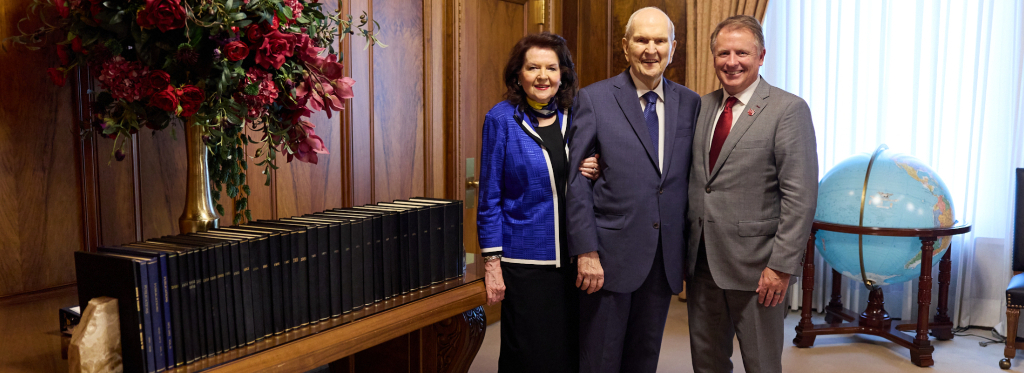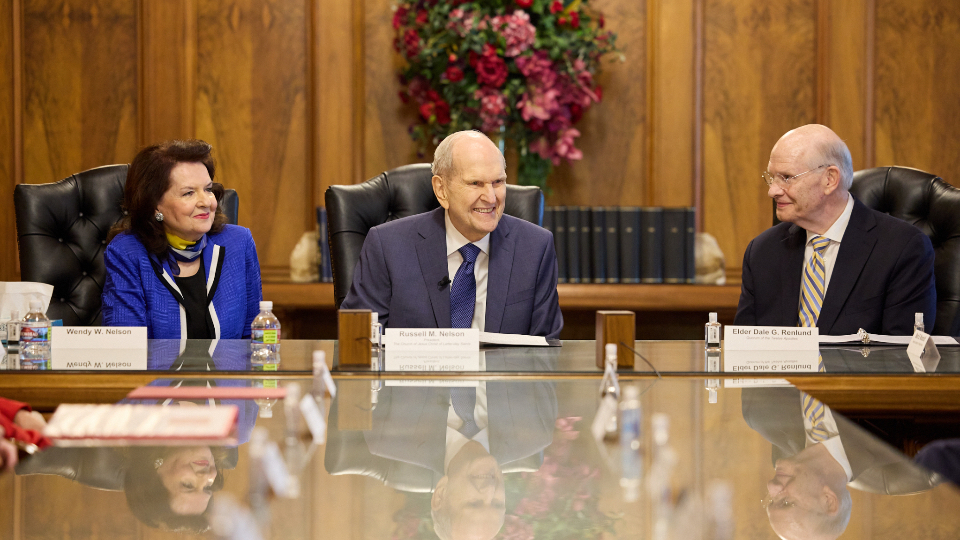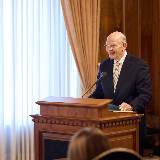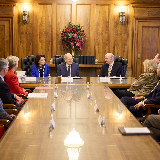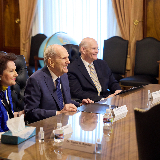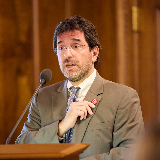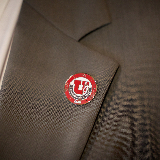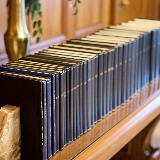President Russell M. Nelson of The Church of Jesus Christ of Latter-day Saints has donated his medical journals and research — 35 volumes in all — to the University of Utah School of Medicine.
The reports of more than 7,000 surgeries “may be needed in particular by any living patients in need of additional operations,” the Church president and former heart surgeon said on Wednesday, August 30, 2023. He spoke at a brief afternoon gathering with University of Utah officials in the First Presidency council room in the Church Administration Building on Temple Square in Salt Lake City.
| President Russell M. Nelson (center) presents a 30-year collection of his medical journals to officials from the University of Utah on August 30, 2023, in the Church Administration Building. 2023 by Intellectual Reserve, Inc. All rights reserved. | 9 / 13 |
President Nelson said the meeting, which was led by Elder Dale G. Renlund of the Quorum of the Twelve Apostles (himself a former cardiologist and University of Utah graduate), was “a historic point in my life.”
Those present included his wife, Sister Wendy Nelson, University of Utah President Taylor Randall, Drs. Sam Finlayson and Craig Selzman (the latter holds the university’s Dr. Russell M. Nelson and Dantzel W. Nelson Presidential Endowed Chair) and Katie Eccles of the university’s board of trustees.
“Whenever a surgical operation is done in a major hospital, a report of that operation is dictated by the surgeon,” President Nelson explained. “I kept copies of all my operative records from 1954 to 1984, when I was called to devote full-time service as a member of the Quorum of the Twelve Apostles. … I am sure the keeper of these records will be mindful of the confidential relationships between doctors and their patients. Therefore, these reports can be made available on an as-needed basis.”
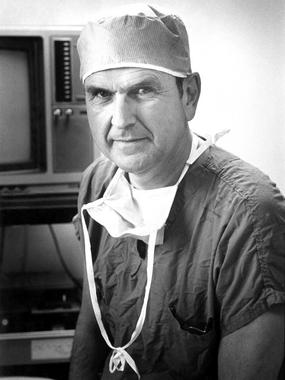
Nelson-heart-surgeon-portrait
Russell M. Nelson in 1982. He was a world-renowned heart surgeon for many years before being called to be an Apostle in 1984.2020 by Intellectual Reserve, Inc. All rights reserved.Eccles expressed gratitude on behalf of her family that the records will be housed in the university’s Spencer S. Eccles Health Sciences Library.
“We are so honored that you have entrusted the University of Utah to catalog and manage these important papers,” Eccles said. “While they are there, they will be accessible to those who want to further medical research. They will be there to motivate new pioneering efforts in cardiology and, perhaps most importantly, to inspire young physicians for generations to come to use their gifts and talents as you did to improve the human condition.”
The volumes comprise 30 books of operative reports, three books of reprints of more than 100 of Dr. Nelson’s scientific publications, a master patient index and Dr. Nelson’s Ph.D. thesis. President Nelson also provided a digitized version of each volume. The only surgical reports not included are those done while he was a visiting professor of surgery in Mexico, Chile, Uruguay and the People’s Republic of China.
“As we appropriately allow individuals to study your records, they will see how you were inspired and [will] remember that you were not only a great healer of people but you’ve been a great healer of souls,” University of Utah President Randall said. “And [they will read] that you felt inspiration the entire time that you were performing your profession, which I think the world in general is in great need of. We thank you deeply for donating these volumes to the University of Utah.”
President Nelson, who turns 99 on September 9, was admitted into the University of Utah School of Medicine in 1944. He received an M.D. degree from there in 1947, at age 22, and a Ph.D. degree from the University of Minnesota in 1954. He returned to Salt Lake City in 1955.
As a physician, President Nelson was perhaps best known for his part in the development of an artificial heart and lung machine small enough to function in an operating room. Made possible by invaluable support and encouragement from his first wife, Dantzel, it was an achievement that heightened his appreciation for the gift of life. “I think a surgeon is in a unique position to understand one of God’s greatest creations — the human body,” he once said. “Every segment of the body motivates me to faith.”
With the heart-lung machine, he performed Utah’s first open-heart surgery in November 1955.
President Nelson served for 17 years as director of the Thoracic Surgery Residency at the University of Utah (which included training at four hospitals) and chairman of the Division of Thoracic Surgery at LDS Hospital in Salt Lake City.
“I am deeply grateful for the important role the University of Utah played in my education and surgical career,” the Church leader concluded. “Wendy and I are pleased to donate these valuable records to the University of Utah. Thank you for accepting these tangible tracts of my surgical career.”
